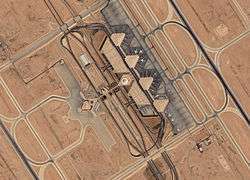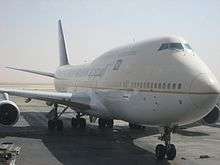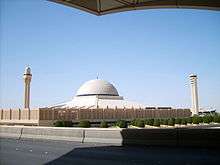King Khalid International Airport
| King Khalid International Airport مطار الملك خالد الدولي Matār al-Malik Khālid al-Duwaliyy | |||||||||||||||
|---|---|---|---|---|---|---|---|---|---|---|---|---|---|---|---|
 | |||||||||||||||
| IATA: RUH – ICAO: OERK | |||||||||||||||
| Summary | |||||||||||||||
| Airport type | Public | ||||||||||||||
| Owner | The Saudi General Authority of Civil Aviation (GACA) | ||||||||||||||
| Serves | Riyadh | ||||||||||||||
| Location | Riyadh, Saudi Arabia | ||||||||||||||
| Hub for |
Saudia Flynas | ||||||||||||||
| Elevation AMSL | 2,049 ft / 625 m | ||||||||||||||
| Coordinates | 24°57′28″N 046°41′56″E / 24.95778°N 46.69889°ECoordinates: 24°57′28″N 046°41′56″E / 24.95778°N 46.69889°E | ||||||||||||||
| Map | |||||||||||||||
 RUH Location of airport in Saudi Arabia | |||||||||||||||
| Runways | |||||||||||||||
| |||||||||||||||
| Statistics (2015) | |||||||||||||||
| |||||||||||||||
King Khalid International Airport (Arabic: مطار الملك خالد الدولي; Maṭār al-Malik Khālid al-Duwaliyy, IATA: RUH, ICAO: OERK) is located 35 kilometres (22 mi) north of Riyadh, Saudi Arabia,[2] designed by the architectural firm HOK, and Arabian Bechtel Company Limited served as the Construction Manager on behalf of the Saudi government.
This airport consists of 5 passenger terminals (only four of which are in use) with eight aero-bridges each, a mosque, covered and uncovered car parking for 11,600 vehicles, a additional Royal Terminal (for the Kingdoms Guests from Government Heads, and Saudi Royal family use), a central control tower (one of the world's tallest), and two parallel runways, which are each 4,260 metres (13,980 ft) long. The land area allocated for this airport is among the largest(second largest after King Fahd International Airport, Dammam) in the world. The airport occupies an area of 375 square kilometres (93,000 acres).
This airport was constructed to meet the increasing international and local air transport requirements for Riyadh. The airport that KKIA replaced, Riyadh Airport (close to the city center), is now a Royal Saudi Air Force airbase. King Khalid International Airport (KKIA) opened for operations in late 1983.
This airport was an alternative landing site for NASA's Space Shuttle.[3]
Terminals
Passenger terminals
_(8886426858).jpg)
There are four main passenger terminals at the airport.
- Terminal 1 is used for all international flights (except those operated by Saudia, Air France, Korean Air, and Middle East Airlines which are Skyteam members and flynas)
- Terminal 2 is used by all international flights for Skyteam members including Saudia, and flynas.
- Terminal 3 is closed for renovations.
- Terminal 4 is unused, having never been utilized since construction, and remains without air bridges. But now it is being developed. The development will last for another five years.[4]
- Terminal 5 is now being used by Saudia and Flynas for domestic flights.
The terminals are connected to each other by means of three linking buildings, These buildings are 168 metres (551 ft) long. Each terminal is triangularly shaped, it has a triangular base of 47,500 square metres (511,000 sq ft) area. The complex includes a modern VIPs terminal plus restaurants, cafeterias, airlines offices, government departments, hotels and rent-a-car companies counters, banks, first aid clinics and commercial shops.
The Royal Terminal

Heads of state and other high-ranking VIP visitors to the Kingdom are greeted in the Royal Pavilion. The Royal Pavilion has open spaces, garden areas, and fountains. A ceremonial hall 12.5 metres (41 ft) wide and 390 metres (1,280 ft) long connects it to the mosque. The design and geometry of the building are similar to those of the other terminals architecturally and in the aesthetic respect. Arriving guests can use either air bridges or escalators to enter the building from the aircraft parking area. The ceremonial area on the airside has space for special receptions involving honor guards and bands. Like the passenger terminals, the Royal Pavilion has a triangular plan, with a roof composed of 33 arched sections rising to a high point 30 metres (98 ft) above the ground level. Glass walls and windows illuminate the interior of the building.
General aviation terminal
A general aviation complex has been constructed north of runway number 1 for use by private aircraft and is reached by a special access road which runs north from the airport access highway. The general aviation facility includes a passenger terminal, aircraft parking and maintenance facilities, taxiways and parking for visitors, tenants and staff. In addition to privately owned aircraft, this facility accommodates Saudia's special flight services group. It's also home to Alsalam Aircraft Company, Ltd. Programmed Depot Maintenance (PDM) on Royal Saudi Air Force aircraft is performed at the uniquely designed facility.
Airlines and destinations

_(8886427334).jpg)
Passenger
^1 : Korean Air's flights from Seoul continue from Riyadh to Jeddah, however Korean Air has no rights to transport passengers between Riyadh and Jeddah.
Cargo
Structure and facilities
| Aspect | Details |
|---|---|
| Runways | 2 |
| Runway length | 4,205 m (13,796 ft) |
| Runway width | 60 m (200 ft) |
| Runway shoulders | 7.5 m (25 ft) x 2 |
| Runway paved blast pads | 120 m (390 ft) x 2 |
| Taxiway width | 23 m (75 ft) |
| Taxiway shoulders | 13 m (43 ft) x 2 |
| Cross taxiway width | 28 m (92 ft) |
| Cross taxiway shoulders | 14.5 m (48 ft) x 2 |
| Large-sized aircraft stands | 20 + 12 royal terminal |
| Small-sized aircraft stands | 22 |
| Cargo aircraft stands | 4 (Large) |
| General aviation stands | 36 |
| Helipads | 1 Royal terminal |
Air traffic control tower
Centrally located in the passenger terminal complex, between the Royal Pavilion and the mosque is the air traffic control tower standing at 81 metres (266 ft) high. Twr Freq. 118.6E & 118.8W. GND 121.6. CD 121.8. Riyadh Dept. 120.0 Riyadh Approach 126.0
There are 19 separate floor levels in the tower, including the operations area at the base of the tower and a total of 1,230 square metres (13,200 sq ft) of floor space. Six of the 19 floors are considered main floors. These include the operational level at the base of the tower, two equipment floors, an observation floor, a service floor and the cab floor at the top of the tower from which the air traffic controllers overlook the entire airport. The operations floor houses the radar control center for the airport as well as conference rooms, offices and a training area. The two equipment level contain mechanical and electrical equipment and cables, and the service floor contains a kitchen, lounge and lavatories for personnel on duty in the cab. The cab itself contains controller operating positions and electronic and communications equipment. The tower is supplied with two sources of standby power should the regular source of power be interrupted. Once source is the standby power supply at the central power plant – three diesel engine generators. In addition, a 300 kilowatt diesel engine located in the tower itself can provide a secondary source of emergency power. The tower is outfitted with the most advanced electronic radar systems and data processing equipment available.
Inter-terminal connectivity
Passengers going from one terminal to another at King Khalid International Airport can utilize moving sidewalks for transportation. The moving walkways, the first to be installed at any Saudi airport, are located in the three link buildings that connect the International and Domestic terminals.
There is a total of 1,196 metres (3,924 ft) of the walkways, which are actually wide conveyor belts which operate at floor level and move at a speed of close to 1 metre per second (2.2 mph).
Additional passenger conveniences in the terminal complex include 80 elevators and escalators. In the parking garages, 16 escalators are provided and two serve the mosque.
The elevators, escalators and moving walkways all have the latest safety equipment installed. Should a fire occur, the elevators would automatically be recalled to the main floors and the doors opened. The escalators and moving sidewalks are equipped with fire and smoke detectors which will cause them to stop automatically should a fire be detected.
Airbridges
KKIA was the first airport in the Kingdom to install airbridges, to speed up handling and turnaround times. Each terminal has eight gates with airbridges effectively eliminating the need for bus journeys between the terminal buildings and waiting aircraft.
The Mosque

The design of KKIA Mosque is one of the most distinct landmarks in the airport by virtue of its Islamic architecture. It can accommodate 5,000 worshipers inside and another 5,000 in the plaza outside.[2] Its location in the center of the passenger terminal establishes it as the most important structure on the airport and makes it the first sight visitors see as they leave the arrival area. The dome is 33 metres (108 ft) in diameter and towers 40 metres (130 ft) above the arrivals level roadway, higher than all of the other structures in the passenger complex with the exception of the control tower and minaret.
In the northeast corner of the mosque plaza, a minaret rises 39 metres (128 ft) above the plaza level. A spiral stairway inside the minaret provides access to loudspeakers that broadcast the call prayers five times daily. There are 5,030 square metres (54,100 sq ft) of floor space on the main floor of the mosque and another 765 square metres (8,230 sq ft) on the mezzanine floor. A Koranic library off of the main mosque floor has 50 square metres (540 sq ft) of user space and the same amount for storage space. The library, private offices and lavatories are located along the southeast on southwest walls.
Landscaping
KKIA has more than 500,000 square metres (5,400,000 sq ft) of landscaping. Over 225,000 trees, vines, shrubs and ground cover plants were used to landscape the airport site and the interior courtyards. A factor in the landscape design was the limited availability of irrigation water. All of the plants selected for the site are tolerant of heat, wind and dry soil conditions. Wherever possible, plants with a history of successful growth in the Riyadh area or similar environments were selected.
Safety
This facility has five separate Fire Houses, with several modern fire fighting vehicles, and trained firefighters. The location also has security equipment and a security force.
Parking facilities
Two large three-level garages have been constructed directly in front of the passenger terminals, one on either side of the airport mosque. They are connected to the terminals and to the mosque by pedestrian walkways under the arrivals level roadway. The design capacity of the garages is 11,600 vehicles. The garages are built of cast-in-place concrete and each covered level is 4 metres (13 ft) high. Escalators and elevators are available in these garages, as well as stairways between the different levels.
Expansion
In July 2014, German construction company Hochtief won the bid for the airport expansion which aims at increasing its capacity from 15 million to 25 million and includes construction of a new fifth terminal.[22] The contract was valued at €1.3 billion and will be carried out by Hochtief with a 55% stake, along with Indian engineering company Shapoorji Pallonji Mideast and Saudi Arabian construction company Nahdat Al Emaar. Construction is expected to be completed by May 2019.[23] Terminal 4 is expected to be equipped with required facilities. KKIA has not witnessed any development since its establishment in 1983.
The airport will be linked with the city's new metro system and the GACA has reached an agreement with Riyadh Development Authority for the purpose. The metro system will help passengers reach the city center quickly and comfortably, adding that spots have been allocated in the project for the metro lines. Saudi Railway Company will construct the main railway station on the southeastern part of the airport to be linked with the terminal through the metro system.
Traffic statistics
The airport has steadily increasing passenger numbers.
| Year | Total passengers | Total Aircraft movements |
|---|---|---|
| 1998 | 8,055,000 | 70,909 |
| 1999 | 8,234,000 | 73,336 |
| 2000 | 8,411,000 | 74,945 |
| 2001 | 8,737,000 | 75,535 |
| 2002 | 9,045,000 | 75,623 |
| 2003 | 9,168,000 | 74,600 |
| 2004 | 9,911,000 | 77,327 |
| 2005 | 10,573,000 | 84,555 |
| 2006 | 11,017,000 | 94,250 |
| 2007 | 11,783,000 | 112,210 |
| 2008 | 11,540,000 | 114,429 |
| 2009 | 12,674,000 | 127,666 |
| 2010 | 13,616,000 | 129,613 |
| 2011 | 14,898,000 | 135,757 |
| 2012 | 17,069,000 | 153,533 |
| 2013 | 18,585,000 | 161,314 |
| 2014 ESTIMATE | 20,900,000 | N/A |
Accidents and incidents
- On 8 May 2009, Saudia MD-90 registration HZ-APW performing ferry flight SV-9061 from Jeddah to Riyadh (Saudi Arabia) with 8 crew on board attempted to exit onto high speed turnoff resulting in the left main gear to collapse and the airplane resting on the left wing. The crew evacuated through the front door slides. No injuries occurred, the airplane however received substantial damage to its left wing.
- On 27 July 2010 at 11:38 local time, Lufthansa Cargo Flight 8460, an MD-11 registered D-ALCQ, crashed upon landing at King Khalid International Airport, Riyadh, Saudi Arabia and was damaged beyond repair in the ensuing fire. The Pilot in command and the First Officer – the only two persons on board – were able to leave the aircraft by themselves.[24][25][26]
References
- 1 2 "OERK – RIYADH/King Khaled International" (PDF). AIP Saudi Arabia. GACA. 22 March 2001. Retrieved 9 August 2012.
- 1 2 "King Khaled International Airport Overview". Flight Stats. Retrieved 9 August 2012.
- ↑ John Pike (20 July 2011). "Space Shuttle Emergency Landing Sites". Globalsecurity.org.
- ↑ "Expansion to up Riyadh airport capacity to 35 m | Arab News – Saudi Arabia News, Middle East News, Opinion, Economy and more". Arabnews.com.
- ↑ "Aegean Airlines Delays Riyadh Launch to July 2015". Airlineroute.net. 27 March 2015. Retrieved 27 March 2015.
- ↑ "Air Arabia Jordan Adds Riyadh Service from April 2016". airlineroute. Retrieved 7 April 2016.
- ↑ http://businessworld.in/article/Air-India-Express-To-Start-Kolkata-Singapore-and-Delhi-Tehran-Service/26-10-2016-107478/
- ↑ "Cebu Pacific Adds Riyadh Service from Oct 2014".
- ↑ UBM (UK) Ltd. 2016 (29 October 2015). "flynas Adds Abu Dhabi / Bahrain Routes from Dec 2015". Routesonline.
- ↑ "Flynas adds Bahrain to GCC network". TradeArabia. 5 October 2015. Retrieved 5 October 2015.
- ↑ "flynas Adds Riyadh – Cairo Route from late-April 2015". Airline Route. 25 March 2015. Retrieved 25 March 2015.
- ↑ JL (3 April 2013). "W6/WU13". Airlineroute.net.
- ↑ "flynas Resumes Riyadh - Lahore Service from late-Aug 2014". Airline Route. 20 August 2014. Retrieved 20 August 2014.
- ↑ UBM (UK) Ltd. 2016 (4 May 2016). "flynas Adds Riyadh – Al Baha Service from late-May 2016". Routesonline.
- 1 2 "flynas Adds New Riyadh Routes from Mar 2016". airlineroute. Retrieved 10 March 2016.
- ↑ "Korean Air ends Saudi Arabia service in Feb 2017". routesonline. Retrieved 23 November 2016.
- ↑ UBM (UK) Ltd. 2016 (4 May 2016). "Pakistan International Increases Saudi Arabia Flights from late-April 2016". Routesonline.
- ↑ UBM (UK) Ltd. 2016 (1 April 2015). "Saudia Adds Riyadh – Wedjh Service from May 2015". Routesonline.
- ↑ "Turkish Airlines Expands Riyadh Service in S16". airlineroute. Retrieved 16 March 2016.
- ↑ "Yemenia Airway".
- ↑ Turkish Airlines Cargo Winter Schedule Archived 4 June 2013 at the Wayback Machine.
- ↑ "Hochtief wins $2.9bn Riyadh airport expansion". Global Construction View. 23 July 2014. Retrieved 7 April 2016.
- ↑ Webb, Alex (30 June 2015). "Hochtief-Led Group Seals $1.5 Billion Riyadh Airport Contract". bloomberg.com. Retrieved 7 April 2016.
- ↑ "UPDATE 2-Lufthansa cargo plane crashes at Saudi airport". Reuters. 27 July 2010. Retrieved 27 July 2010.
- ↑ "BBC News – Lufthansa cargo plane crashes at Riyadh airport". Bbc.co.uk. 27 March 2010. Retrieved 27 July 2010.
- ↑ "Flight 8460 at the Aviation Safety Network". Aviation-safety.net. 27 July 2010.
External links
| Wikimedia Commons has media related to King Khalid International Airport. |
- King Khalid International Airport Riyadh
- Accident history for RUH at Aviation Safety Network
- Aeronautical chart for OERK at SkyVector
- Current weather for OERK at NOAA/NWS